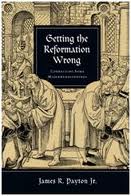 James R. Payton Jr., Getting the Reformation Wrong: Correcting Some Misunderstandings (Downers Grove, IL: IVP Academic 2010). Paperback / Kindle
James R. Payton Jr., Getting the Reformation Wrong: Correcting Some Misunderstandings (Downers Grove, IL: IVP Academic 2010). Paperback / Kindle
Every now and then, I hear friends describe—denounce, really—some book as a work of “revisionist history.” What they mean by that appellation is that the book contains a false account of the past. And while they may or may not be correct in their evaluation, what strikes me is their misunderstanding of the historical task. By nature, all historical writing is revisionist. That is, the task of historians is to revise our present understanding of the past through better methodologies and more accurate information. They don’t always succeed in doing so, but they (should) always try. Absent their efforts, we run the risk of misremembering the past and acting in the present on the basis of misleading, if not false, history.
In Getting the Reformation Wrong, James R. Payton Jr. engages in a revisionist history of the 16th-century Reformation in order to correct popular misunderstandings of that seminal movement, especially among North American evangelicals. Successive chapters deal with the following misunderstandings:
- The Reformation did not originate de novo in the 16th century (chapter 1). Rather, the events of the 16th century built on the desire felt throughout Western Christendom in the preceding two centuries for reformatio in capite et membris—Latin for head-to-toe reformation. The reformers may have capitalized on this long-felt desire, but they did not create it.
- The Renaissance and Reformation were not competing movements (chapter 2). Instead, they were complementary movements. Indeed, with the notable exception of Luther, most of the first generation of Protestant reformers were “humanists,” that is, advocates of a liberal arts education as opposed to a medieval scholastic education.
- The Reformation did not emerge rapidly or smoothly (chapter 3). Rather, in the early years, different people were attracted to Luther for different reasons, not all of them having to do with justification by faith. For example, the Peasant Revolt drew inspiration from themes in Luther’s writings, even though Luther himself specifically—and forcefully—condemned the revolt.
- The Reformers did not agree with one another (chapter 4). Indeed, their disputes were sometimes rancorous and led to longstanding rifts within the movement.
- The Reformers did not dispute the importance of good works in the life of the Christian (chapter 5). They agreed that we are justified by faith alone (sola fide), but they also agreed that the faith by which we are justified is not alone. It produces good works.
- Similarly, the Reformers did not think that the Christian life could dispense with church tradition (chapter 6). They believed in Scripture alone (sola fide) as the final, unquestioned authority in the life of the church. But they also believed that tradition (e.g., creeds, councils, confessions, etc.) could play a subordinate role.
- Regarding the so-called “radical reformation,” Payton shows that 16th-century Anabaptists were not predecessors of Baptists, incorporated a broader range of groups than modern-day Anabaptists, and originated in multiple places, not just in Switzerland (chapter 7).
- The Counter Reformation was not merely a response to the Protestant Reformation (chapter 8). Rather, based on a centuries-old desire for head-to-toe reformation, various Catholic reform movements spread up before, along with, and outside of the Protestant Reformation.
- Late-16th– and early-17th-century Protestant scholasticism was not necessarily a natural outgrowth of the earlier Reformation (chapter 9). Rather, it represented a significant shift in methodology and emphasis.
- The Reformation was not an unalloyed success, at least not according to the Reformers’ own stated goals (chapter 10).
- Similarly, if we pay attention to the teaching of the Reformers, then we cannot see the Reformation as a theological norm or “golden age” (chapter 11).
This bullet-pointed summary of Getting the Reformation Wrong doesn’t do justice to Payton’s nuanced argumentation, though it alerts you to the topics he addresses. The book is gracefully written, fair-minded, and insightful on a range of topics. I was especially impressed by the chapters on the events preceding the Reformation (chapter 1) and on the Catholic movements for reformation (chapter 8). The desire for reformatio in capite et membris was both widespread and ecumenical.
Payton’s final chapter asks whether the Reformation was a triumph or a tragedy, and concludes that it was both. Triumph: “it rediscovered and boldly proclaimed the apostolic message, the Christian gospel.” Tragedy: “divisions among the Protestant Reformers have mushroomed among their descendants in contravention of the explicit words of Jesus Christ himself” (i.e., in John 17:20–21). “It is at least a horrendous anomaly,” Payton writes, “that the sixteenth-century Reformation got rid of the clutter that obscured the foundation of the Christian faith, only to have Protestants cover that foundation again with the clutter of our manifold divisions.”
To which this Protestant can only say: “Lord, have mercy!” And also, thank God for revisionist historians who bring such problems to light!
P.S. If you found this review helpful, please vote “Yes” on my Amazon.com review page.

